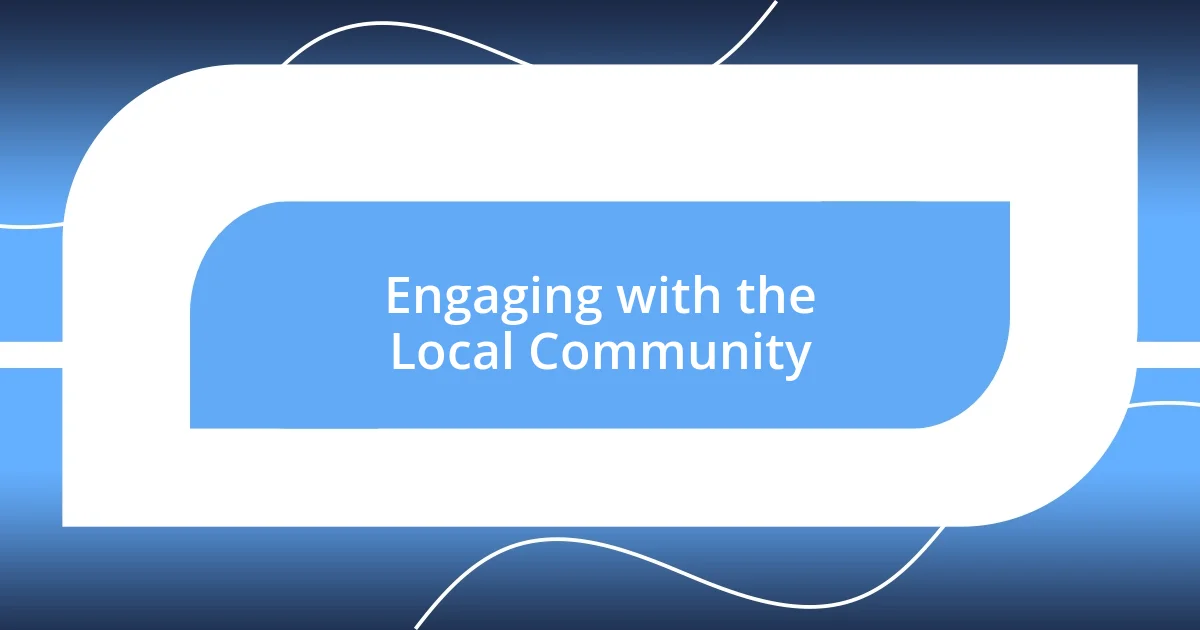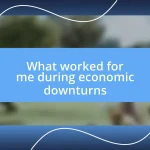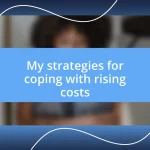Key takeaways:
- Street art acts as a powerful means of expression, reflecting societal issues and personal experiences while fostering a sense of community.
- Engaging with local artists and participating in street art events enhance the understanding and appreciation of the art through shared stories and collaborative experiences.
- Documenting and sharing street art explorations through photography and social interactions enriches the journey and promotes dialogue within the art community.

Understanding Street Art Culture
Street art culture is a fascinating blend of creativity, rebellion, and community expression. I remember my first encounter with a vibrant mural in an alleyway—it was like stepping into another world, alive with color and emotion. Have you ever stopped to think about the stories behind these powerful images? Each piece often reflects the artist’s thoughts on society, politics, or personal experiences, making every artwork a window into their soul.
As I delve deeper into this culture, I’ve come to realize that street art serves as a voice for those who often feel unheard. It challenges norms and provokes conversations that might not happen otherwise. I once stood mesmerized in front of a large mural depicting a community battle for rights, feeling a mix of anger and hope. How can a simple wall become such a powerful platform for change? It’s the raw honesty of these artworks that captures my heart.
The communal aspect of street art is equally significant. I’ve experienced the energy of group art projects, where strangers join forces to create something extraordinary. There’s this undeniable sense of belonging when I pick up a spray can and link arms with fellow artists. Don’t you think street art brings us closer together in a world that often feels divided? It reminds us that we’re all part of a broader story, stitched together by our shared experiences and aspirations.

Discovering Iconic Street Artists
Discovering iconic street artists is like uncovering hidden gems in a vast cityscape. Each artist brings a unique perspective that adds depth to the urban environment. I recall my visit to the Wynwood Walls in Miami, where I first encountered the works of Shepard Fairey. His bold graphics and thought-provoking messages left me inspired and asking questions about consumerism and power dynamics. Isn’t it incredible how an artist can express such complex ideas through seemingly simple images?
As I continued my exploration, I stumbled upon Banksy’s provocative stencils. I couldn’t help but feel a thrill at discovering pieces that are often tucked away from view. One particularly striking piece depicted a little girl letting go of a balloon, symbolizing loss and freedom. It made me reflect on my own experiences with letting go and the bittersweet nature of change. The raw emotional honesty in Banksy’s art often resonates with viewers, inviting them to find meaning in their personal narratives.
I often compare different street artists’ styles and themes. The contrast between someone like Jean-Michel Basquiat, whose work is full of chaotic energy and powerful social commentary, and the understated sophistication of artists like Kaws with his playful yet poignant characters is fascinating. Each artist speaks a different language, narrating their stories through vibrant hues and intricate designs. Do you have a favorite street artist that connects with you on a deeper level? I find that exploring these diverse expressions not only enriches my understanding of the art but also of the world around me.
| Artist | Style |
|---|---|
| Shepard Fairey | Bold graphics with political messages |
| Banksy | Provocative stencils that provoke thought |
| Jean-Michel Basquiat | Chaotic energy and social commentary |
| Kaws | Playful characters with deeper meaning |

Techniques for Taking Great Photos
Capturing street art in its essence requires a keen eye and a few smart techniques. I often find that the time of day can drastically impact the mood of a photograph. Early morning or late afternoon provide softer light, which enhances colors and details. And then there’s the location—the right angle can transform an ordinary shot into a mesmerizing piece of art. For instance, while photographing a mural, I remember getting low to the ground and shooting upward. The perspective made the artwork feel grander, almost larger than life.
Here are some techniques I swear by for great street art photography:
- Play with light: Natural light is your best friend. Golden hour softens the harsh lines and makes colors pop.
- Explore angles: Don’t settle on the first viewpoint. Change your height, distance, and angle to find a unique perspective.
- Incorporate surroundings: Use the urban landscape to frame the art. Trees, buildings, or even people can add depth and storytelling elements.
- Focus on details: Sometimes, zooming in on small aspects of the mural or the textures of the wall can lead to captivating shots that tell a different story.
- Capture the interaction: Include people in your shots to show how they engage with the art. Their expressions can deepen the narrative of the photograph.
On another occasion, I did a late-night photo walk through an abandoned area of the city. The stark contrast between the brightly colored murals and the darkness surrounding them created a haunting yet beautiful atmosphere. I learned the power of shadows and highlights in my captures. I felt like I was part of a secret world that few others got to see—a feeling of intimacy that I still chase in my photographs today.

Identifying Popular Street Art Locations
When it comes to identifying popular street art locations, I often find that some cities have areas that are almost like living galleries. Take Berlin, for example. It’s fascinating how neighborhoods like Kreuzberg or Friedrichshain are filled with art on nearly every corner. During one of my visits, I remember wandering through the streets and being completely mesmerized by the sheer variety of styles—everything from vibrant murals to subtle stickers. Isn’t it amazing how a single street can tell so many stories through these visuals?
I’ve also noticed that local art tours often highlight key spots where street art flourishes. In my experience, joining one of these tours leads to unexpected discoveries. During a guided walk in Melbourne, I stumbled upon a hidden alley filled with incredible abstract pieces. The guide shared anecdotes about the artists and their intentions, which made me appreciate the art on a whole new level. Have you ever been surprised by something you found while exploring?
Another great strategy is to connect with online communities or social media platforms dedicated to street art. I’ve often followed hashtags related to specific cities, and this has led me to uncover lesser-known gems. For instance, I once discovered a tiny courtyard in Buenos Aires filled with stunning murals that I wouldn’t have found on my own. It only takes a little digging to find these incredible locations, and the thrill of the hunt is part of what makes street art exploration so rewarding. Who would have thought that in the shadow of high-rises, there could be such vibrant creativity waiting to be discovered?

Engaging with the Local Community
Engaging with the local community is such a vibrant part of my street art exploration. I remember during a weekend in Lisbon, I struck up a conversation with a local artist while admiring her work on a wall. She shared not just the story behind the mural but also insights into the neighborhood’s hidden gems. It was in that moment that I realized how vital local voices are in truly understanding the art around us. Have you ever considered how much richer your experience could be by reaching out to community members?
I often seek out street art events—like festivals or gallery walks—where artists and fans come together. Just last summer, I participated in an event where I met several passionate creatives. One artist painted a breathtaking piece live, and I felt the energy shift as the crowd gathered. Watching him work, I found it fascinating how he interacted with onlookers, transforming mere spectators into part of the artistic process. The thrill in the air was palpable, reminding me that art isn’t just about the finished piece, but also about community and collaboration. Have you experienced that energy in a similar setting?
In some neighborhoods, street art serves as a bridge to address social issues, and engaging with local advocacy groups can provide a deeper understanding of the messages behind the art. Once, while exploring a community mural focusing on mental health awareness, I met volunteers who shared their personal stories. Their passion was inspiring, and it deepened my appreciation for the art’s purpose. Connecting with the reasons behind these artworks often leads to eye-opening conversations that extend beyond the visuals. Isn’t it incredible how art can spark dialogue and even a sense of belonging?

Tips for Documenting Your Findings
When documenting your findings, I’ve found that taking clear, well-lit photographs makes all the difference. On a recent trip to Mexico City, I snapped pictures of several pieces at different times of day to capture how the light interacted with the colors. It was amazing to see how the artworks transformed from vibrant in bright sunlight to moody when shadowed. Have you ever noticed how the atmosphere around street art shifts with the changing light?
Keeping a journal can also be incredibly beneficial. I always carry a small notebook with me for jotting down thoughts, impressions, and artist names right on the spot. On one occasion, after viewing a striking piece in San Francisco, noting down my feelings made me appreciate the art’s impact later when I reflected on my experience. How often do we forget the emotions we feel in the moment? Writing it down preserves those insights.
Finally, tagging locations and sharing your findings on social media can create a dialogue with fellow art lovers. I remember posting about an astonishing mural in Bristol, and within hours, I received comments from local artists who shared even more context about it. Interacting on these platforms can deepen your understanding, connecting you with communities that feel as passionate about street art as you do. What stories could your finds unlock for others?

Sharing Your Street Art Journey
When it comes to sharing my street art journey, I love utilizing social media to connect with others who share my passion. One time, I posted a picture of a stunning mural I discovered in Berlin, and the response was incredible. Not only did fellow enthusiasts express their appreciation, but many shared their own experiences of visiting that same spot, creating a rich tapestry of stories that truly enhanced my understanding of the art and its context. Have you ever thought about how a simple post could turn into a conversation that shapes your perception of art?
I also find great joy in participating in local community forums or art discussions. I distinctly remember attending a panel talk hosted by street artists in my city. As they passionately discussed their work and the challenges they face, I felt a wave of inspiration wash over me. It was a reminder of how important it is to articulate our experiences and learn from one another. How often do we miss out on profound insights simply because we don’t engage in these conversations?
Creating a dedicated blog or website can be an enriching avenue as well. I started documenting my explorations online, and it became a fun way to reflect on my adventures. One evening, after writing a piece about urban murals, a reader reached out to share their own street art experiences. That connection sparked a delightful exchange of ideas and insights. Isn’t it fascinating how sharing your journey can lead to unexpected relationships and new perspectives?














